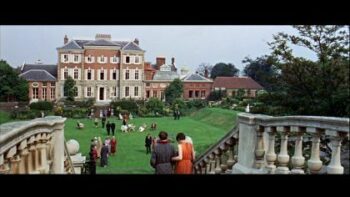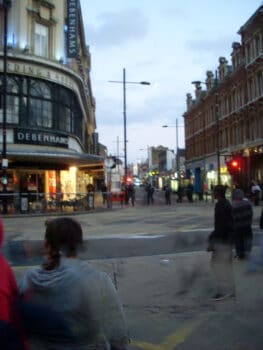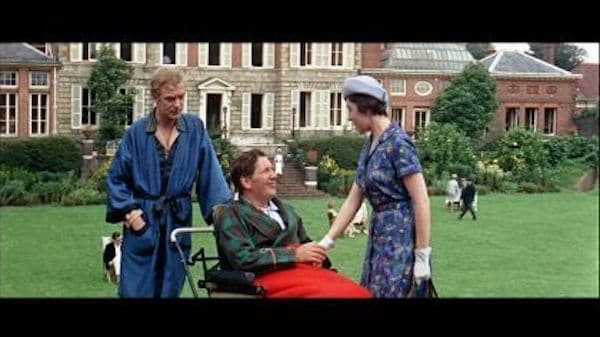In the post-Christmas edition of the United Kingdom’s daily socialist newspaper the Morning Star, the editorial commented on the holiday television broadcast of the 1983 film Educating Rita.1 In it, author Jim Leman pointed out that the 1980s story of a mature working-class hairdresser attempting to enter university, encouraged by a benign academic on tenure, could not happen today. The mandatory student grant that would have supported such a path was abolished and fees were introduced (neoliberal New Labour was responsible for this betrayal). Prior to this cut, the Housing Benefit for students that would have covered her rent was withdrawn courtesy of the Tories. Consequently, student debt in the United Kingdom is now approaching U.S. levels. Workplace casualization has also meant that there are few academics with tenure enjoying enough time on their hands to mentor working-class students in the manner romanticized in Educating Rita. Today, if you are born into a working-class or under-class background, you can expect to stay there.
Given the Orwellian corporate news media’s constant rebooting of history, covering up the redistribution of wealth from “the people’s commons” to the rich, and its rewriting of accounts of once-accepted basic minimum social standards, the mirror of past popular culture offers a welcome illustration of how current generations have been cheated. Many of the young are now worse off than their parents and even grandparents, but are media force-fed variants of the old Prime Minster Harold McMillan’s cliché: “you’ve never had it so good.”

When shadows are discovered on his chest x-rays, Alfie spends time at a sanatorium in the country. York House and gardens on York Street in Twickenham, Middlesex. Screen capture from Alfie (1966) via Reelstreets.
In the 1960s, the UK films Alfie (1966) and Twice Round the Daffodils (1962) were both partly located in National Health Service (NHS) nursing homes, positioned in country seclusion for the treatment of tuberculosis. In the 1960s and ’70s, the UK welfare state boasted “cradle-to-the-grave” care. In the same era, a woman going to a hospital for a serious gynecological operation could expect a couple of weeks of postoperative hospital observation, followed by an extended period in a green belt convalescence home, because the welfare state acknowledged women’s unpaid social workload and protected them from injuriously being thrust back into it.
These days, nursing homes have almost all been sold off, along with numerous fire stations and even some police stations. The capital investment of past generations in the welfare state has been asset-stripped to favor tax cuts for the rich. Convalescence is for the most part not medically resourced, and instead economically dumped onto equally underfunded social services. The now underfunded NHS does not even necessarily treat patients until recovery. Patients can go years with unresolved illnesses. Instead, managers boast of completed procedures—whether these are appropriate or successful procedures is not featured in managerial or government press releases.

Alfie stands by as fellow patient Harry Clamacraft (Alfie Bass) says goodbye to his wife Lily (Vivien Merchant). York House in Twickenham. Screen capture from Alfie (1966) via Reelstreets.
Since the Blairite era, the NHS stopped being a public service and is instead run on the model of a post-Fordist Japanese car factory. It has an exploitative two-tier workforce. To justify insufficient nursing employment, care is sacrificed in time and motion calculations of nurses’ numbered paces and speed moving between beds. Patients face a rationing computerized testing regime and appointment system, which blocks them from accessing treatment too quickly, in the same way that just-in-time car manufacturing stops anything beyond the specifically regulated flow of expensive components into the factory. Patients that complete this process uncured are simply put in line for another set of queues through the system—this is rebooted as if they had not been failed and, in statistical terms, have only just asked for help. In essence, the limitations on the NHS’s performance are planned and deliberately hidden. Yet the UK media during this period has fronted Blairite/Tory neoliberal boasts about NHS performance.
The playwright Jack Rosenthal’s low-fi romantic-comedy drama The Lovers (1973) functions as an interesting snapshot of 1970s Manchester. Far from the corporate Babylonian marketplace it has now degenerated into, intermittently populated by homeless people, gray-exploited faces of gig-economy workers, and desperate time-poor overstretched commuters, the city then depicted was not simply a place of economic exploitation, but of communally lived working-class spaces, social interaction, even offering time for lingering reflective moments. Sadly, Manchester has now followed London in economically absenting its working class from its city-center housing.

Clapham Junction in Nighthawks (1981).
The 1967 Nell Dunn drama Up the Junction attempted to humanize the then topical issue of pregnancy outside marriage. It is set around the socially cohesive working class and then moderately well-maintained area of London’s Clapham Junction. Released in 1981, presumably shot the year or so previously, the terrorist drama Nighthawks also has some scenes set around this time, in the still socially accessible Clapham Junction area. In this last hangover from the postwar consensus, the images suggest in this period you could almost eat your supper from the street tarmac. In the subsequent neoliberal era, this area has become known for homeless rough sleeping, drug dealing, occasional sex work, and the detritus of fast-food capitalism. Despite this, the same economic restructuring that produced this failing environment—from once resourced public good to tax cuts for the private purses of the rich, changing the commons to arenas of corporate exploitation—have been unleashed on Manchester’s and Britain’s other city areas, with similar results.

Clapham Junction as the uprising begins. Image from Human Rights Investigations.
In 2011, protests against the police shooting of a Black man from Tottenham resulted in antiracist uprisings, some of which spilled into other areas of London, including the Clapham Junction shopping area, where demonstrators began stealing goods and damaging property. In the north, Manchester was one of a number of cities that experienced copycat phenomena. David Starkey, a right-wing television historian, claimed this was all due to the proliferation of a supposedly criminalizing Black street patois. No one in the corporate media at the time blamed the police shooting or, despite the place’s cultural history, the social fragmentation generated by the introduction of brutal neoliberal economics. In 2014, in contrast to the filmic representations of the area from the postwar consensus era, the Huffington Post observed that “Clapham Junction remains divided three years on.”2 Subsequent research has defined Clapham Junction as economically deprived.3 Surely, if corporate media’s assertions about the success of neoliberal globalized capitalism were accurate, the 1960s and ’70s pre-Thatcherite-resourced representations of the area should not be looking like some sort of comparative golden age.4
Arguably the most devastating of the betrayals of Bill Clinton’s presidency, aided by Hillary Clinton, was the 1990s introduction of the notorious three-strikes mass incarceration policy, which secured the U.S. position as the world’s foremost imprisoner of its own citizens. Given the role of poverty, deprivation, and resulting emotional neglect in criminality—and as predicted by many critics at the time—victims of the policy have been disproportionately Black.
“More African American adults are under correctional control today—in prison or jail, on probation or parole—than were enslaved in 1850, a decade before the Civil War began,” wrote Michelle Alexander in The New Jim Crow.5 When faced with opposition to their policies, the Clintons ignored socioeconomic factors in criminality and claimed to be simply combating Black “super predators.”6 It was subsequently revealed that the Clintons were taking “donations” from the private-prison lobby. Hillary Clinton was outed for still taking such donations in the run up to her 2016 presidential campaign.7
It is interesting what the history of popular culture can tell us about debates around socioeconomic status, criminality, and prison. There are many strands to the genre of prison dramas. Leaving aside the sexually exploitative, most represent serious issues and contemporary debates. The issue of human wastage and loss of societal talent can be found in films ranging from the Golden Globe- and British Academy Film Awards-winning The Bird Man of Alcatraz (1962) to the Emmy-winning Jericho Mile (1979). Even the documentary music concert Johnny Cash at San Quentin (1969) features interviews with prisoners illustrating this point. Poor conditions and resulting economic exploitation can be found in films from Riot Cell Block 11 (1954) to Brubaker (1980). All-white casts have metaphorically depicted the Black experience of being used as a cheap economic resource by prisons, in films such as I’m Am a Fugitive from a Chain Gang (1932) and the Oscar-winning Cool Hand Luke (1968). The issue though is not that presidential administrations should necessarily be taking their policy advice from privileged Hollywood leading actors. What the reflection of historic popular culture tells us is that powerful politicians, with the support of privatized industry, can ignore decades of public sentiment—often informed by academic and policy debates—and invent an entirely unsupported public service position, take this to the corrupt and compromised corporate news media, who will then collude in generating a new invented reality, or “invented tradition.”
One of the more interesting texts about how debates and even national identity can be rebooted is historian Eric Hobsbawm’s The Invention of Tradition (1983). In it, he describes how national attributes, social and/or generic practices, and iconography can be almost conjured out of the ether, then represented as preexisting or long-term, in order to sustain a narrative of political dominance. Given recent armed protests in the United States, it is worth confronting the Fox News/National Rifle Association/arms industry-driven narrative that the United States has always been obsessed with the Second Amendment—the right to bear arms.
The Western has been the most prolific of Hollywood genres—at times making up to 60 percent of all Hollywood main feature, B-film, and serial production. By the 1950s, its thematic preoccupation was U.S. social-foundation mythology; civilization coming out of wilderness with the birth of the town. Curiously for a violent action genre, most of the films around this time deal with getting guns out of “civilized” areas. The celebrated Shane (1953) concludes with a reference to getting “all the guns out of the valley.” A good deal of this era’s production also deals with the “town-tamer” theme. In films such as Man with a Gun (1955), Gunfight at the OK Corral (1957), Warlock (1959), and Rio Bravo (1959), a man or small group impose order by banning guns from towns. The latter film starred John Wayne and was directed by Howard Hawks. Neither man is known as a left-wing liberal pacifist. Nor is this an unrepresentative moment in Hollywood history, as most of these town-tamer films take their template from John Ford’s My Darling Clementine (1946).8
By the 1960s, the same attitude to guns can be found in popular television fiction. Right-wing actor Robert Taylor was infamous for turning in fellow actors at hearings of the House Un-American Activities Committee. However, on his television show The Detectives (1959–62), his politics did not stop him from having his character confiscate weapons from citizens, on the basis that they were likely to do something they may later regret. Arguably the biggest television hit of the 1960s was The Fugitive. The 1966 episode “In a Plain Paper Wrapper” featured then child actor Kurt Russell ordering a rifle by mail order and, subsequently, accidentally shooting a young friend. The law enforcement officers represented are aghast at the ease at which he procured a weapon. Right-wing libertarian critics may shrug this off as just “liberal Hollywood” but decades later, in Bowling for Columbine (2002), Michael Moore would cite the real example of Kayla Rowland—6 years old—shot and killed by a classmate, albeit in circumstances aggravated by the Clintons’ welfare-to-work program, which had forced the young perpetrator’s mother out of the family home. Many tragic school shootings occurred before this instance and have since.
In any case, historic public policy demonstrates similar concerns about gun availability. Today, many of those taking to the streets are clothed in body armor and are free to carry military-type assault rifles. However, in the 1920s and ’30s, up to twenty-seven states, including New York, Texas, and West Virginia, banned the technologically more primitive Tommy gun (Thompson Machine Gun) on the basis of its hazard to law enforcement officers as the weapon of choice of bootlegging Prohibition gangsters. Furthermore, “the National Firearms Act of 1934 required registration and a tax of $200 [almost $3,600 in today’s dollars] on all so-called gangster weapons.”9
Similarly, after years of societal and police violence, members of the Oakland Black Panther Party for Self-Defense availed themselves of the right to carry shotguns in public and used them to patrol their neighborhoods. But when Black members of the public began carrying firearms, the right was abolished and taken away in the Mulford Act. Significantly, Republican California governor and future extreme right-wing president Ronald Reagan said that he saw “no reason why on the street today a citizen should be carrying loaded weapons” and that guns were a “ridiculous way to solve problems that have to be solved among people of good will.” In a later press conference, Reagan said the Mulford Act “would work no hardship on the honest citizen.”10 Even in the context of what may have been a strategic double-standard manifestation of Reagan’s well-documented racism, and more overtly as historical popular culture confirms, the supposed national obsession with gun ownership in its current iteration is a historically very recent invented tradition.11
The cultural contradictions generated by the West’s recent descent into a racist-imperialist foreign policy model warrant their own essay or larger project, but they will be briefly touched on here. The West in the postwar era, comparable to its confrontation with European fascism, was forced to recognize the racism of its historic imperialism and consequently embarked on a process of forced, and some willing, decolonization. That an attack, however brutally successful, by fifteen Sunni Wahhabist Saudi Arabians and four others should be used to open the door for new wars of exploitation and strategic dominance on other societies, in ethno-sectarian terms incompatible with Saudi Arabia, is an undeniable invented propaganda cultural contradiction in itself.
Beyond that, the historic public sensitivities and antiwar and anti-imperialist cultural production generated by U.S. failings and atrocities in the Vietnam War—Apocalypse Now (1979), Born on the Fourth of July (1989), The Boys in Company C (1978), Casualties of War (1989), Coming Home (1978), The Deer Hunter (1978), Full Metal Jacket (1987), Platoon (1986), and many more—only serve to illustrate how the agenda of armies occupying other people’s countries has been manipulatively misrepresented by the U.S. establishment, with the support of its corporate news media, to the exclusion of other voices.
Of course, much cultural production of the later Reaganite years can be cited to the contrary, such as Missing in Action (1984), Rambo: First Blood Part II (1985), the television show The A-Team (1983–87), but these contrived dog-whistle heroics have little cultural kudos or “realist” credibility. By contrast, the Star Trek films and television franchise, with its prime directive of noninterference in other cultures, has persisted for over fifty years. And it bears repeating that Muhammad Ali is still possibly the United States’ most revered athlete after describing the county’s wars abroad as “the domination of white slave masters of the darker people the world over.”12
In the United Kingdom like in the United States, the corporate news media does its utmost to defend the racist-imperialist agenda without actually admitting it exists. In multicultural Britain, this presents another problem, its Black minority populations, including non-Muslims, are starting to say that these are the policies responsible for the conquest and enslavement of our own ancestors. The result is that sections of the media are now trying to reboot the history of British imperialism, particularly when confronted with those who wish to tear down the statues of major imperialists.
The oddity of this is that in the postwar era you could hardly make a UK film set in the former British empire—from traditional exploitative Boys’ Own adventure genres with white actors playing Natives to prestigious productions—without, for reasons of credibility, featuring British torture. Some examples are The Brigand of Kandahar (1965), The Long Duel (1967), and the award-wining series The Jewel in the Crown (1984). Other films simply coded as critical of empire include Lawrence of Arabia (1962), The Charge of the Light Brigade (1968), Conduct Unbecoming (1976), and Ghandi (1983).
There were three main reasons for this. Postwar immigrants from the Black commonwealth brought oral family histories of mistreatment at the hands of the British with them.
Second, postwar, many Britons serving abroad included conscripts rather than the willing volunteers of previous eras. Britain was still committing offenses of torture and military rape in Cyprus, operating en masse torture camps in Kenya, torture and shoot-to-kill policies in Malaysia, and shoot-to-kill policies in Aden,—some of the returning conscripts from these places were less than happy with what they had been ordered to do, as well as their treatment when they returned, and had their own oral histories.13
Third, at the start of the twentieth century, the British Board of Film Censors had forty-one different criteria for repressing content in film, many of these designed to preserve existing power relations and prevent criticism of empire, such as: references to controversial politics; relations of capital and labor; scenes tending to disparage public characters and institutions; realistic horrors of warfare; scenes and incidents calculated to afford information to the enemy; incidents with a tendency to disparage our allies; scenes holding up the king’s uniform to contempt or ridicule; the exploitation of tragic incidents of the war; and subjects dealing with India in which British officers are seen in an odious light or otherwise attempting to suggest the disloyalty of British officers, native states, or bringing into disrepute British prestige in the empire.14
By the second half of the century, these constraints had mostly been withdrawn from fiction films, opening the floodgates of representation. Ironically, in the era of the new imperialism, a good deal of this filtering censorship now appears to be editorially reimposed by corporate news media on their pro-establishment content.
Very few of the cited filmic texts here are particularly radical or revolutionary. The economic logic of their existence, however, is located in another era of capitalism, and even these past representations tend to function as haphazard critiques of the extremist oligarchical capitalism and territorial dominance of our own era. In George Orwell’s 1984 (1948), the character Winston Smith is given the task of obliterating past narratives from the public domain that contradict new establishment orthodoxies. Thankfully, in what could be argued to be dialectical process, the logic of repertory cinema exhibition coupled with an era of proliferation of channels and streaming platforms cheaply filling airtime with old syndicated material means we are never far from texts that make a lie of the invented traditions of corporate news media’s repressive new ideologies.
Notes:
- ↩ Jim Leman, “‘It’s Not the Past I Miss but Communities with a Future,’” Morning Star, December 24, 2020.
- ↩ Will Martindale, “Riot Recovery: Why Clapham Junction Remains Divided Three Years On,” Huffington Post, August 8, 2014.
- ↩ Clapham has a lower rate of home ownership (via mortgage or owned outright) than the national average, which suggests that Clapham is an economically deprived area. “Socio-Economic Statistics for Clapham, Lambeth,” I Live Here UK, accessed February 3, 2021.
- ↩ The Tories won the May 1979 general election making Margaret Thatcher prime minister. Nighthawks was released in 1981 and shot prior to that year, in the period before Thatcher’s policies had started to bite. However, by the summer of Nighthawks’s 1981 release date, race riots had broken out in Brixton—this just three miles away from Clapham Junction. This was an uprising by Brixton’s Black community against severe harassing and often violent policing. Apparently, fully let off the leash by the pro-law and order Tories, the police were targeting Black citizens without due cause, on the basis of an elderly right of “suspicion” this harassment became known as the “sus laws.” Rising unemployment and the harshness of the welfare system under Thatcher also meant that Black citizens were often on the street and easy targets for police who were accused of acting like an occupying army.
- ↩ Michelle Alexander, The New Jim Crow: Mass Incarceration in the Age of Colorblindness (New York: New Press, 2010), 180. For another reference to Michelle Alexander, see Thoai Lu, “More Black Men Are in Prison Than Were Enslaved in 1850,” Ministry to Men (blog), March 20, 2013.
- ↩ Michelle Alexander described Clinton’s endorsement of the super predator concept as “racially coded rhetoric” used to “cast black children as animals.” Anne Gearan and Abby Phillip, “Clinton Regrets 1996 Remark on ‘Super-Predators’ After Encounter with Activist,” Washington Post, February 25, 2016.
- ↩ H. A. Goodman, “Marco Rubio and Hillary Clinton Accepted Almost the Same Amount of Prison Lobbyist Donations,” Huffington Post, February 9, 2016; Lee Fang, “Private Prison Lobbyists Are Raising Cash for Hillary Clinton,” Intercept, July 23, 2015.
- ↩ Another film from the earlier era, Angel and the Badman (1947), concludes with gunfighter John Wayne giving it all up to settle down with a family. In the final scene, the sheriff picks up Wayne’s discarded pistol and, alluding to the escalation that potentially arises from having a weapon, he states: “only those carrying a gun need a gun.”
- ↩ Gabe Bullard, “That Time Mob Violence Inspired Gun Control in America,” National Geographic, June 14, 2016.
- ↩ Adam Winkler, “The Secret History of Guns,” Atlantic (September 2011).
- ↩ Sarah Mervosh and Niraj Chokshi, “Reagan Called Africans ‘Monkeys’ in Call with Nixon, Tape Reveals,” New York Times, July 31, 2019.
- ↩ “Muhammad Ali Refuses to Fight in Vietnam (1967),” Alpha History, accessed February 3, 2021.
- ↩ Samuel Osborne, “UK Pays £1m Damages to Cyprus ‘Victims of Rape and Torture by British Colonial Forces,’” Independent, January 24, 2019; Adam Smith, “British Soldiers ‘Horrifically Tortured Children’ During Cyprus Emergency,” Metro, May 23, 2018; Caroline Elkins, Britain’s Gulag: The Brutal End of Empire in Kenya (New York: Pimlico, 2005); Christi Siver, “The Other Forgotten War: Understanding Atrocities During the Malayan Emergency,”Political Science Faculty Publications 8 (2009); Robert Verkaik, “Secret Colonial-Era Files Reveal British Cover-Up of Torture in Aden,” National News, October 15, 2017; Mark Townsend, “New Documents Reveal Cover-Up of 1948 British ‘Massacre’ of Villagers in Malaya,” Guardian, April 9, 2011; Nicholas Mercer, “Cruel Britannia: A Secret History of Torture,” openDemocracy, December 4, 2012.
- ↩ “1916 – T. P. O’Connor,” BBFC, accessed February 3, 2021.

